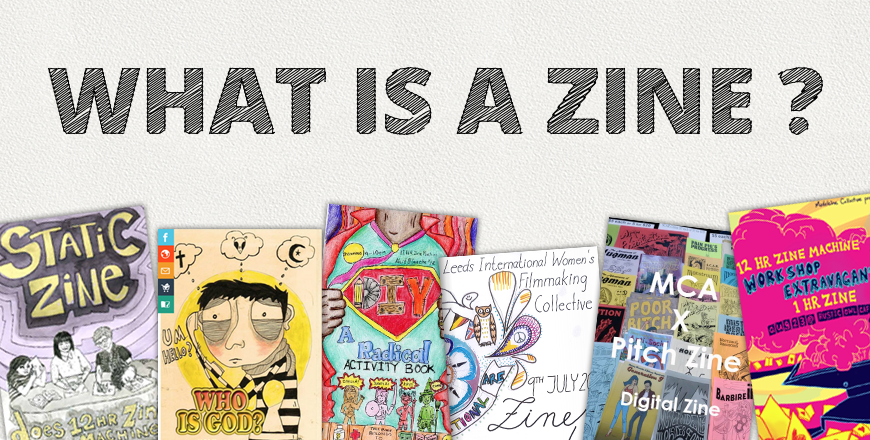It’s an online tool that offers a glimpse of the future and takes you back to the 90s at the same time. Nathalie Lawhead’s Electric Zine Maker has brought joy to many creative internet users, a tool disguised as a toy that lets them design an artwork known as zines.
In fact, the internet zine is enjoying a surge in popularity across the world, allowing amateur designers to express themselves and sometimes turn their designs into viral sensations. The pandemic has been partly responsible for this, with increased online use leading to a spike in creative publications.
But what exactly is a zine, and what makes them so appealing to fans?

A brief history of zines
Zines are handmade, photocopied fan publications that first entered the public domain way back in the 1930s when readers of sci-fi fanzines exchanged them privately or at public events. They hit new heights during the 70s, when punk art and poetry touched mainstream thinking, and eventually lead to the famous Riot Grrrl era, later on, a movement that embraced themes such as feminism and racial equality.
A big reason behind the zine’s popularity was the autonomy it gave to fans. They could create something spontaneous about one of their passions and, what’s more, receive positive kudos from people who shared the same interest as them. While the zine’s cheap-looking collage aesthetic was down to the limited technology of the time, they’ve managed to maintain their cult status today through personal websites and blogs. The internet has also made sharing zines way easier: what once took months, if not years, to attract a widespread following can now be done in just a few moments.
Websites like the Electric Zine maker has tapped into that, exploiting a niche in the online market. Zine fans can combine the graphics and fonts of yesteryear and use modern-day tools to give them a digital edge. It’s super easy to get started: you’re presented with a virtual A4 page which you can fold to make an A8 leaflet. You can then use image pasting and paintbrushes to put down your initial design and add digital twists like filters and text boxes to enhance it. The colours are bright and vivid and will take some people back to the cartoons of the 80s and 90s.
By having one foot in two ages, those of the pre-internet and the digital era we’re in today, the best online zines have truly gone to the next level – and another popular pastime has helped to fuel that.
Zines and video games
You may ask how zines are related to online games. After all, they occupy two completely different areas of the creative market.
Well firstly, we play games for many reasons, depending on the type we choose. An online card game, such as Solitaire, appeals to our urge to solve puzzles; games of chance, such as lotteries, appeal to our dreams of wealth and status, which is why lottery jackpots are so attractive, despite the chances of winning being virtually zero.
Video games, on the other hand, allow us to act out our fantasies, whether it’s masterminding a military operation or soaring through the sky like an eagle. We also might want to make this world for ourselves, which is why creation games are so popular. Here is where we can see the crossover into zine territory. Want to design your own character as well as the world it inhabits? Give Animal Crossing a try. Fancy making your own version of an all-time classic? Super Mario Maker’s the game for you.
Such creative license leads author and game designer Anna Anthropy to even describe these creation video games as zines in themselves in her book Rise of the Videogame Zinesters. The two, after all, are intrinsically linked, they both give us the tools to transfer what’s in our mind to another medium, whether it be on the screen or on paper. They both fuel our creativity.
The success of these creation games has put player autonomy into the mainstream, showing video game players how fun creating your own design, characters, and even the online world, can be.
Online zines are another way of doing this, and their ease-of-use and retro look make them a simple and cool way of doing that.
The future of zines
So, what next for zines, – will they embrace the arrival of 5G technology and flourish in new ways? Or will they be an afterthought in the rush towards an Internet of Things, where anything is possible online?
Well, zines certainly have a good track record of handling change. From their humble 1930s origins through to Natalie Lawhead’s hit website, they’ve seen the rise and fall of many fashions, movements and crazes to keep a special place in the heart of their fans.
Gaming experts predict big things for video games over the next decade, and maybe zines will go hand-in-hand with them, as ever. Machine learning and AI could see us walking around in a virtual online world almost identical to real life, so why not a fully interactive zine made by the fans, for the fans?
Check out more of our features such as interviews and opinion pieces by clicking HERE.